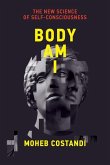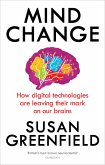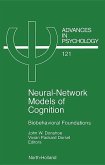- Broschiertes Buch
- Merkliste
- Auf die Merkliste
- Bewerten Bewerten
- Teilen
- Produkt teilen
- Produkterinnerung
- Produkterinnerung
This book demonstrates network science applications in psychology, ageing, creativity, memory, language evolution, belief structures, child language learning, and group problem-solving. Designed for graduate students and researchers in the cognitive sciences, behavioural economics, and health and social policy.
Andere Kunden interessierten sich auch für
![Phi Phi]() Giulio TononiPhi40,99 €
Giulio TononiPhi40,99 €![How the Mind Works How the Mind Works]() Steven PinkerHow the Mind Works23,99 €
Steven PinkerHow the Mind Works23,99 €![Body Am I Body Am I]() Moheb CostandiBody Am I31,99 €
Moheb CostandiBody Am I31,99 €![Mind Change Mind Change]() Susan GreenfieldMind Change23,99 €
Susan GreenfieldMind Change23,99 €![Neural Network Models of Cognition Neural Network Models of Cognition]() J.W. Donahoe / V.P. Dorsel (eds.)Neural Network Models of Cognition177,99 €
J.W. Donahoe / V.P. Dorsel (eds.)Neural Network Models of Cognition177,99 €![Curious Minds Curious Minds]() Perry ZurnCurious Minds20,99 €
Perry ZurnCurious Minds20,99 €![ON CONSCIOUSNESS ON CONSCIOUSNESS]() Bernard J BaarsON CONSCIOUSNESS47,99 €
Bernard J BaarsON CONSCIOUSNESS47,99 €-
-
-
This book demonstrates network science applications in psychology, ageing, creativity, memory, language evolution, belief structures, child language learning, and group problem-solving. Designed for graduate students and researchers in the cognitive sciences, behavioural economics, and health and social policy.
Produktdetails
- Produktdetails
- Verlag: Cambridge University Press
- Seitenzahl: 428
- Erscheinungstermin: 19. Dezember 2024
- Englisch
- Abmessung: 251mm x 181mm x 21mm
- Gewicht: 728g
- ISBN-13: 9781108793339
- ISBN-10: 1108793339
- Artikelnr.: 70160751
- Herstellerkennzeichnung
- Libri GmbH
- Europaallee 1
- 36244 Bad Hersfeld
- gpsr@libri.de
- Verlag: Cambridge University Press
- Seitenzahl: 428
- Erscheinungstermin: 19. Dezember 2024
- Englisch
- Abmessung: 251mm x 181mm x 21mm
- Gewicht: 728g
- ISBN-13: 9781108793339
- ISBN-10: 1108793339
- Artikelnr.: 70160751
- Herstellerkennzeichnung
- Libri GmbH
- Europaallee 1
- 36244 Bad Hersfeld
- gpsr@libri.de
Dr Thomas Hills is a Professor of Psychology at the University of Warwick. He directs the Behavioral and Data Science MSc at the University of Warwick, concentrating on how humans represent and navigate information in the mind and society. He has previously held fellowships with the Alan Turing Institute and the Royal Society.
Part I. A Brief Guide to Network Science: 1. Making and recognizing networks
2. Network metrics
3. Generative network models and network evolution
Part II. Language and Learning: 4. Zipf's law of meaning: the degree distribution of the mind
5. Network learning: growing a lexicon by degrees
6. What is distinctive: exploring edge types in multi-layer networks
7. The small-world spectrum: using small worlds to compare networks
8. The birthplace of new words: identifying node origins
9. Agent-Based models of language emergence: structure favors the orangutan
Part III. Mental Processes: 10. False memories: spreading activation in memory networks
11. Cognitive foraging: exploration versus exploitation in memory search
12. Age-related Cognitive Decline: a network enrichment account
13. Creativity: how noisy processes create novel structure
Part IV. Social Dynamics: 14. Network illusions: how structure misleads us
15. Group problem solving: harnessing the wisdom of the crowds
16. The Segregation of belief: how structure facilitates false consensus
17. The conspiracy frame: coherence through self-supporting beliefs
18. The Kennedy paradox: games of conflict and escalation
19. Fund people not projects: a universal basic income for research
References.
2. Network metrics
3. Generative network models and network evolution
Part II. Language and Learning: 4. Zipf's law of meaning: the degree distribution of the mind
5. Network learning: growing a lexicon by degrees
6. What is distinctive: exploring edge types in multi-layer networks
7. The small-world spectrum: using small worlds to compare networks
8. The birthplace of new words: identifying node origins
9. Agent-Based models of language emergence: structure favors the orangutan
Part III. Mental Processes: 10. False memories: spreading activation in memory networks
11. Cognitive foraging: exploration versus exploitation in memory search
12. Age-related Cognitive Decline: a network enrichment account
13. Creativity: how noisy processes create novel structure
Part IV. Social Dynamics: 14. Network illusions: how structure misleads us
15. Group problem solving: harnessing the wisdom of the crowds
16. The Segregation of belief: how structure facilitates false consensus
17. The conspiracy frame: coherence through self-supporting beliefs
18. The Kennedy paradox: games of conflict and escalation
19. Fund people not projects: a universal basic income for research
References.
Part I. A Brief Guide to Network Science: 1. Making and recognizing networks
2. Network metrics
3. Generative network models and network evolution
Part II. Language and Learning: 4. Zipf's law of meaning: the degree distribution of the mind
5. Network learning: growing a lexicon by degrees
6. What is distinctive: exploring edge types in multi-layer networks
7. The small-world spectrum: using small worlds to compare networks
8. The birthplace of new words: identifying node origins
9. Agent-Based models of language emergence: structure favors the orangutan
Part III. Mental Processes: 10. False memories: spreading activation in memory networks
11. Cognitive foraging: exploration versus exploitation in memory search
12. Age-related Cognitive Decline: a network enrichment account
13. Creativity: how noisy processes create novel structure
Part IV. Social Dynamics: 14. Network illusions: how structure misleads us
15. Group problem solving: harnessing the wisdom of the crowds
16. The Segregation of belief: how structure facilitates false consensus
17. The conspiracy frame: coherence through self-supporting beliefs
18. The Kennedy paradox: games of conflict and escalation
19. Fund people not projects: a universal basic income for research
References.
2. Network metrics
3. Generative network models and network evolution
Part II. Language and Learning: 4. Zipf's law of meaning: the degree distribution of the mind
5. Network learning: growing a lexicon by degrees
6. What is distinctive: exploring edge types in multi-layer networks
7. The small-world spectrum: using small worlds to compare networks
8. The birthplace of new words: identifying node origins
9. Agent-Based models of language emergence: structure favors the orangutan
Part III. Mental Processes: 10. False memories: spreading activation in memory networks
11. Cognitive foraging: exploration versus exploitation in memory search
12. Age-related Cognitive Decline: a network enrichment account
13. Creativity: how noisy processes create novel structure
Part IV. Social Dynamics: 14. Network illusions: how structure misleads us
15. Group problem solving: harnessing the wisdom of the crowds
16. The Segregation of belief: how structure facilitates false consensus
17. The conspiracy frame: coherence through self-supporting beliefs
18. The Kennedy paradox: games of conflict and escalation
19. Fund people not projects: a universal basic income for research
References.








